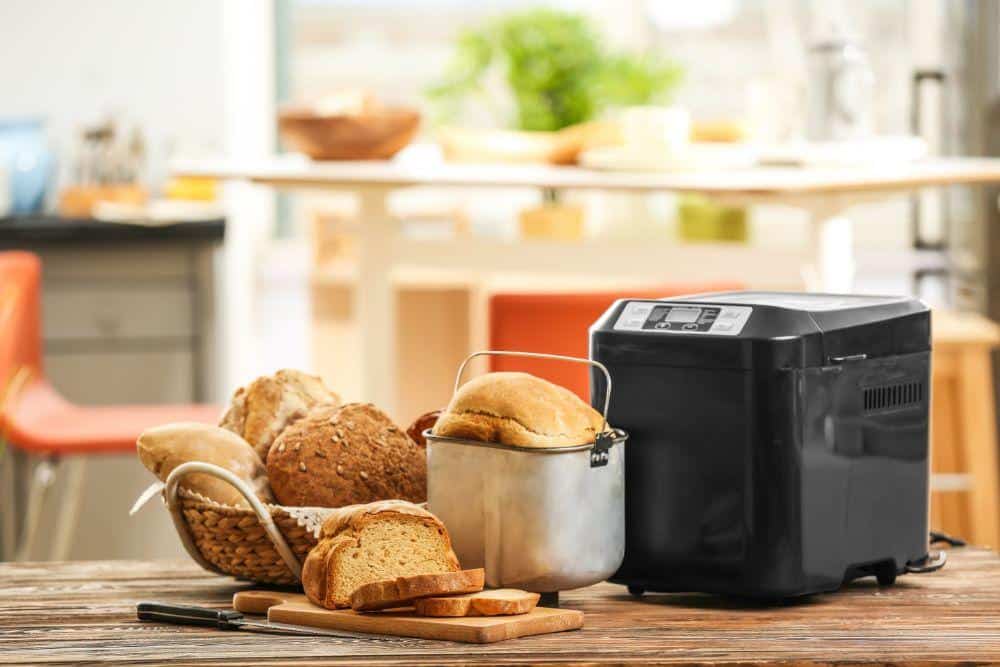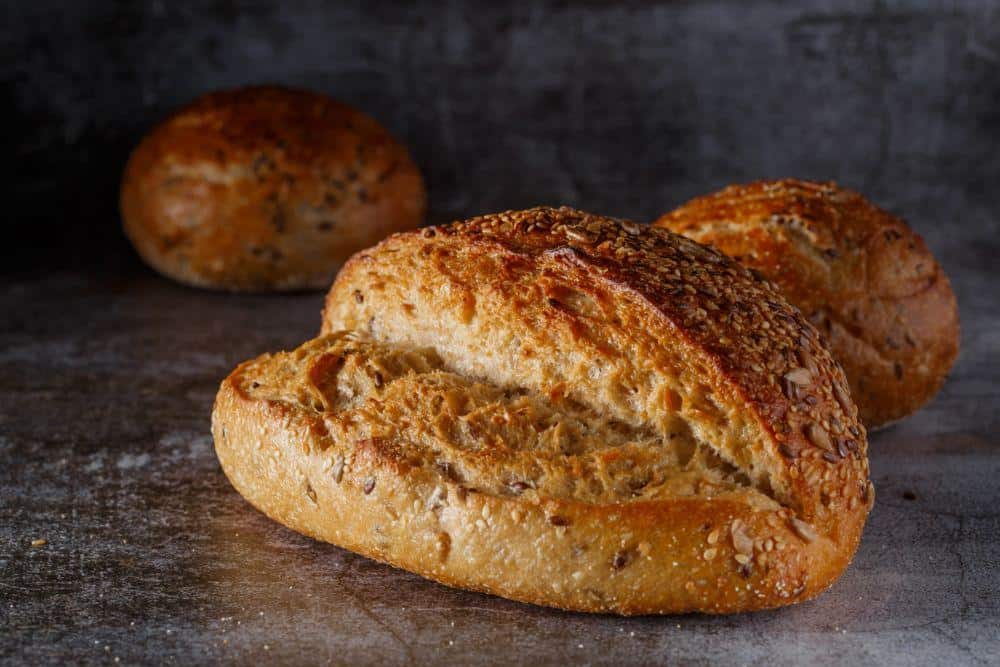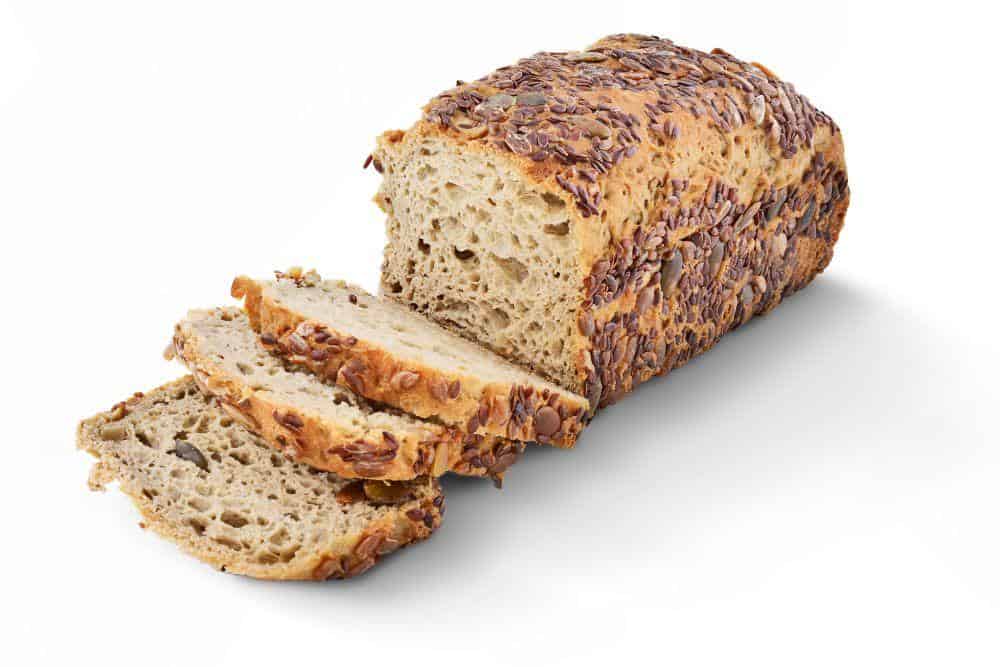Making homemade bread is a process that has been around for centuries, so there are now many different ways to bake a quality loaf. Two popular methods are a convection bread maker and a regular bread machine. Each has its pros and cons and the one you need will depend on your own preferences.
Some people state that the difference between a bread machine and a bread maker is that a bread maker generally only has one function: bake bread. On the other hand, a bread machine often has additional functions, such as making pizza dough or jam.

A Bread Machine Next to Freshly Baked Bread
The truth is that these terms are interchangeable. The primary purpose of a bread machine is to ingest all the required ingredients and bake bread automatically without any human help.
The issue of which is better, a convection bread maker or a regular bread machine, comes down to personal preference. Some people prefer the taste and appearance of bread made in a bread machine, while others find that the texture is better when baked in a regular oven.
There are also those who find that using a convection machine saves time and energy, while others find that the process is more complicated and prefer the simplicity of a regular bread machine.
So what about the convection bread maker vs. the regular bread machine? Which is a better choice?
Convection heating uses air currents to circulate heat evenly around an object. Ovens and toaster ovens utilize this type of heating.
A convection bread maker uses convection heating to bake bread. This bread maker has a fan that moves hot air around the bread as it bakes, resulting in evenly-baked loaves.

Convection Breadmakers bake a bit more quickly and provide a nice browned, evenly baked loaf of bread
Convection bread makers are generally pricier compared to regular bread makers.
A regular bread machine uses radiant heating or resistance heating to bake bread. Radiant heating involves elements emitting heat, which then cooks the food. Resistance heating passes an electric current through a coil of wire, which creates heat that cooks the food.
Since the heating element is on the bottom, regular bread makers can produce unevenly baked bread.
Bread cooked in a machine is different than bread cooked in an oven. The dough is mixed and kneaded inside the device, so it doesn't get the same aeration that it would from being kneaded by hand. This results in a denser, more compact loaf of bread.
Sometimes the denser loaf is preferable, such as when making sandwich bread. Other times, people prefer the fluffier texture of oven-baked bread.
Bread makers often have settings for different types of bread, such as white bread, whole wheat bread, or gluten-free bread. There may also be settings for different loaf sizes, such as 1.5-pound or 2-pound loaves.
Some bread machines also have a delay timer, so you can add the ingredients and set the timer for when you want the bread to finish baking - this is convenient if you want to wake up to fresh bread in the morning.
Regular and convection bread machines have a lot in common. They're both convenient and easy to use.
Both machines have paddles that knead the dough. Both devices have settings for different types of bread and loaf sizes. They also both have delay timers.
Many bread machines have options to adjust the texture of the bread. For example, you can select a light, medium, or dark crust setting.
Both types of bread makers come with a recipe book. The recipes in the book are similar, but the convection bread maker's recipe book has more detailed instructions.
The heating element is the main difference between the bread makers. Regular bread makers have an element on the bottom, whereas a convection bread maker has a fan that circulates hot air around the baking chamber.
Convection bread makers are generally more expensive than regular bread makers because the baking technology is more advanced.
There is no question that bread machines are convenient. You just combine the ingredients, select the cycle, and let it run. But what if you want to get a little more hands-on with your baking? Or what if you're going to bake something other than bread?

Bread Machines Make Many Different Types of Bread with Their Preprogrammed Settings
You can make a cake in a bread maker or use it as a rice cooker. Jam is a popular setting among many bread makers. The machine heats and stirs the ingredients while a thickening agent gradually creates the desired texture.
Sauces and soups are also easy to make, and you can also use the bread maker to knead the dough for pies and pizzas. Scrambled eggs and yogurt are other items you can prepare in your bread maker.
There are two types of bread makers: one paddle and two paddles. The paddles mix and knead the dough until it is ready for baking.
Two paddle bread makers have a traditional horizontal baking pan. One paddle machines have tall square pans.
Two paddles provide a superior bread making experience. They allow a machine to handle a larger quantity of dough and knead the dough evenly to create a well-textured loaf. Two paddles are also helpful when dealing with heavy flours like whole wheat and rye. Additional strength is required to get these doughs ready for baking.
Baking bread with one paddle machines restricts you to a smaller capacity. With one paddle, the bread maker can't really knead the dough evenly. While a fresh loaf of bread from a one paddle machine is still delicious, the bread may have air pockets or be misshapen.
There are two types of regular bread makers: those that have a removable pan and those that do not. The removable pan type is easier to use, as you can take the bread out when baking is complete.
The type that does not have a removable pan can be more challenging, as you need to turn the bread to cook it evenly.
There are various sizes of bread makers, from 1-pound loaves to 2.5-pound loaves. Your size will depend on the number of people in your household and how often you bake bread.
The average family of four will need a 2-pound loaf machine. If you have a large family or bake bread frequently, you may want a 2.5-pound loaf machine.
Non-stick bread makers are handy, and the temperatures in the machine do not get hot enough to raise health concerns regarding non-stick baking materials. Some reviewers state that non-stick materials can become hazardous when scratched and chipped, so use non-abrasive utensils.
Demo of a Cuisinart Convection Bread Machine
Cuisinart makes several convection bread makers. The one that you choose will ultimately depend on your own preferences and budget. Each Cuisinart bread maker described below comes with different features - the CBK- 200 is a bit more expensive than the CBK-110. Most have the ability to create a custom loaf size with up to 2 lb loaf capacity. They also have up to 3 crust colors (light, medium, dark) and bake a variety of bread types from their recipe book including:
French bread
Gluten Free Bread
Pizza Dough
Banana Bread
Sweet Bread (Brioche, Chocolate Cherry, Challah)
This model makes 1, 1.5, and 2-pound loaves. There are three crust options and 12 menu programs available, and you can remove the lid, paddle, and bread pan for cleaning. A convenient 13-hour delay timer lets the Cuisinart bake bread while you're at work.
The CBK-110 bakes up to a 2-pound loaf and mixes, rises, bakes, and warms. It features three crust options and 12 baking programs. An LCD provides easy-to-read information.
The CBK 200 bread maker makes up to 2-pound loaves and features 16 preprogrammed menu options. A signal tells you when to add nuts and fruit to the dough and a 12-hour delay option. Three loaf sizes and three crust colors are available.
So, which is the better choice? It depends on your needs and desires. If you want consistent results, then a convection bread maker is the way to go. However, a regular bread machine will be fine if you're on a budget.
It is easier to make consistently great bread in a convection machine due to the even, distributed heat. You can make excellent bread in a regular machine, but it takes more care, practice, and observation.
Because a regular bread maker heats from the bottom, the loaf can collapse during baking or after removal from the bread maker. The bottom can burn if the dough doesn't sit evenly.
Bread cooked in a convection maker looks better. Just as convection heat cooks evenly, it gives your bread an even brown color. A regular bread marker often leaves the bottom of the loaf darker than the top.
Non-stick surfaces and programmable timers are both desirable features. Convection machines offer even baking and consistent results, but they are more expensive than regular machines. Ultimately, the decision comes down to preference and the amount of bread you need to produce.
Convection bread makers are more expensive than regular bread machines, but they are worth the investment if you want to ensure that your bread cooks evenly every time.
